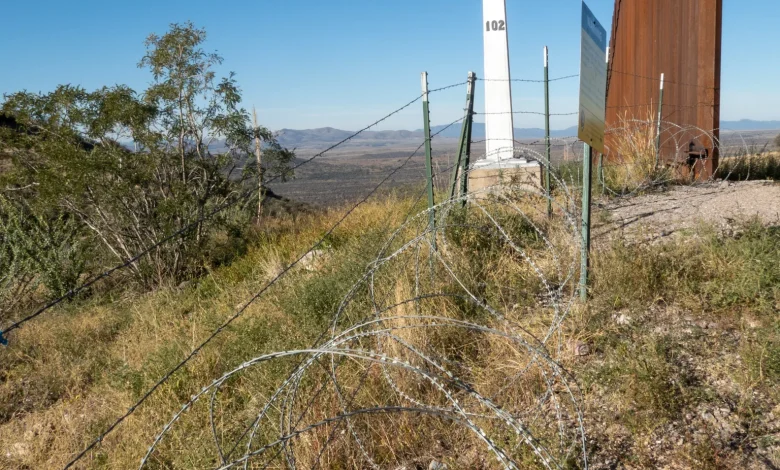Arizona Trail Southern Terminus Blocked by Razor Wire, Hikers Warned Not To Cross

Contractors for the Department of Homeland Security (DHS) have reportedly installed concertina wire blocking access to the southern terminus of the Arizona Trail, according to the Arizona Trail Association (ATA). The 800-mile national scenic trail begins at Border Monument 102 just north of the Mexican border, within Coronado National Memorial, and terminates at the Arizona-Utah border on the Kaibab Plateau.
“If you are among the thousands of AZT thru-hikers who were able to capture a photo of your accomplishment at Border Monument 102, consider yourself fortunate. That seems to now be a part of the trail’s history,” the ATA wrote in an Instagram post yesterday.
Impacts on Hikers
In the same post, the organization also warned that border wall construction projects taking place west of the terminus, including blasting to create gravel, are likely to cause “auditory and visual impacts” for hikers in the area.
ATA Executive Director Matthew Nelson told The Trek that the organization was not given advance notice of either the concertina wire installation or the blasting and only became aware of these activities through reports from hikers and volunteers.
“Under normal circumstances, DHS communicates with the land manager, whether that’s Coronado National Forest or Coronado National Memorial, which is National Park Service, and then they would reach out to us, but because most of their staff is not working, or they’re furloughed (due to the government shutdown) … there is no communication at all.”
The southern terminus pictured in spring 2025, prior to the concertina wire installation. A barbed wire fence has always run in front of the border monument, but hikers were previously able to cross to the other side to take photographs with the marker. Photo: Good Zen
A source familiar with the subject confirmed to The Trek that they had observed the concertina wire at the trail’s southern terminus on November 3 and said they believed it had been installed between October 21 and November 3.
Nelson also noted that AZT hikers have reported being questioned by Border Patrol agents with dogs, but The Trek did not independently verify these claims.
The DHS did not immediately respond to a request for comment for this story.
A Trend of Increasing Border Fortification
Photo: K. Flynn
Border Patrol agents, DHS contractors, and the military have reportedly installed new border fortifications and concertina wire elsewhere along the Arizona-Mexico border this year, including near Nogales and Yuma.
Meanwhile, the creation of a National Defense Area in neighboring New Mexico has restricted access to the southern terminus of the Continental Divide Trail, another national scenic trail beginning near the Mexican border.
A simple barbed-wire fence has long marked the border in the area of the AZT, including in front of the terminus. During the previous Trump administration, a short section of steel bollard fencing was also installed.
Yet the monument is still on the US side of the border, and until now, Arizona Trail hikers could cross the fence for photographs. Now, the ATA is urging hikers not to cross the newly installed concertina wire in the interest of safety.
The organization also indicated in a blog post that they anticipate additional steel wall construction in the area next August, which could result in trail closures “to protect trail users from construction activities.”
What’s Next for the AZT?
Nelson says the ATA hopes to build a “proper southern terminus” monument in the same style as the northern terminus monument pictured here. Photo: Passtrek
Nelson said the organization had already been working with the National Park Service on a plan to build a new, more accessible monument north of the fencing. “What we’d like to do is build a proper southern terminus, similar to the one that we built on the northern terminus with the border of Utah.”
Besides impacting hikers, critics of border wall construction projects have raised concerns about the projects’ potential to degrade the region’s pristine viewsheds and fragile ecosystems.
“The borderlands have become a militarized zone, even in remote and beautiful areas like the southern terminus of the Arizona Trail,” Nelson told The Trek via email. “And the gentle whisper of wind through the grasslands has been shattered by blasting nearby to make gravel for concrete footers for the big wall construction project to the west. This landscape is undergoing massive transformation.”
Featured image courtesy of K. Flynn.
Affiliate Disclosure
This website contains affiliate links, which means The Trek may receive a percentage of any product or service you purchase using the links in the articles or advertisements. The buyer pays the same price as they would otherwise, and your purchase helps to support The Trek’s ongoing goal to serve you quality backpacking advice and information. Thanks for your support!
To learn more, please visit the About This Site page.




